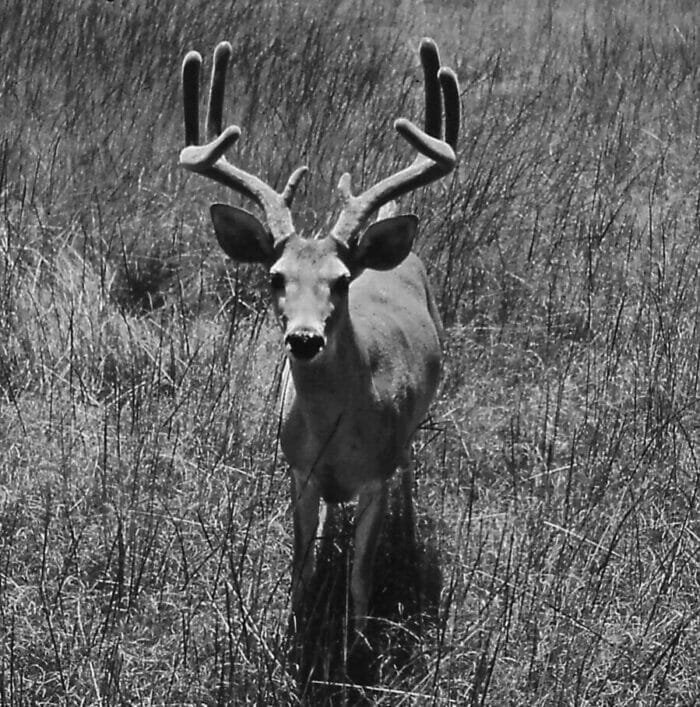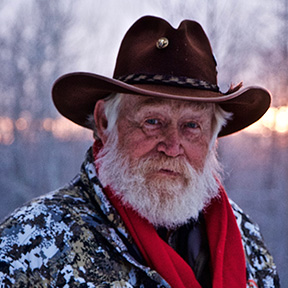He Wore Gray Velvet
It had been a long day. It started two hours before first light and continued to a few minutes nigh of midnight, the third of such rather lengthy days.
Lack of sleep, coupled with many hours of “windshield time,” was starting to take its toll. For two days, I had been conducting night-time spotlight deer surveys in the northeastern part of our great and huge State of Texas on a ranch where I worked with their wildlife program. In return for my services, I have the right to take one buck each hunting season. A perfect trade, in my opinion.
The buck I chose to take my first year was an ancient 6-point, with an inside spread of 14 inches just beyond the region’s legal 13-inch inside main beam spread minimum. In taking that particular buck, I was not so much concerned he would pass on his scant 6-point rack to his offspring as I wanted to keep the buck from eating forage that a buck with considerably bigger antler potential could eat.
Antler Growth Explained
Antlers, especially big racks for their respective age class, are a sign of a healthy deer herd. Yes, genetics play an important role in antler development, but so do nutrition and age. Age, in the fact that most bucks in the southern climes do not mature body-wise, meaning all long bones and muscles are fully developed until they are 4 years of age. Bucks in the northern regions of North America mature at 3 years of age. Once a buck’s skeletal and muscle systems are fully developed, any nutrition not required for body maintenance can be channeled into developing antlers. This is one of the reasons mature bucks generally have bigger antlers than younger or immature bucks.
Antlers on bucks seen in East Texas were, at the time of our deer census, the 2nd week of August, fully developed but still retained velvet. Most bucks in Texas as elsewhere start shedding velvet in early to mid-September.
The East Texas census results revealed a nearly 1 to 1 buck to-doe ratio and a 50% fawn survival rate. Pretty impressive on the low-fenced property, but also the result of adjoining neighbors being on the same basic management program as the ranch I work with.
After driving nearly 7 hours west, still a long way from crossing a Texas border, to arrive at the lease I am involved in, I spent the late afternoon driving the property checking on water sources and looking at deer. I saw several does and fawns and a couple of bucks. They, like the ones I had observed in the eastern part of Texas, were still “in velvet,” as expected. They, too, looked like their racks were fully mature and in the final stages of hardening. Had the antler tips still been bulbous, I would have known the antlers were still developing. Once the tines covered with velvet are pointed, they have completed their growth.
The bucks in western Texas, like the bucks in eastern Texas, had fully developed antlers (this the middle of August) but still retained velvet, the short-haired gray “skin” that covers developing antlers and carries nutrients to the growing or developing bone that turns into antler. And yes, antlers are actual bones, very similar to the bones in our or the deer’s legs. The difference is antlers are cast or shed each year, usually in late winter. When antlers drop, almost immediately, the buck starts developing new ones.
Antler development is a most interesting process. Antlers develop from the pedicels on top of the heads of the various deer species. “Velvet,” the skin covering growing antlers, harbors nerves which shape the antlers and blood vessels which carry nutrients to the growing and developing bone that will become antlers. When antler development is complete, the velvet comes off, and the antlers are polished by rubbing against brush and trees. Doing so polishes the antlers and strengthens neck and shoulder muscles. Antlers are used to fight with other males to establish dominance and possibly influence does. Once the breeding season has passed, the antlers are cast or shed during winter, and the process starts all over again.
Increasing daylight hours trigger antler development, along with an increase in testosterone, the male sex hormone. Late winter, and early spring, bucks start to develop antlers, the second fastest growing tissue (second only to the rapid growth of some cancer cells) known.
In spring and summer, testosterone levels continue increasing slowly. Once the antlers are completely developed and hardened in late August and early September, there is a rapid and dramatic increase in testosterone. When this happens, blood vessels on the surface of the antlers previously carrying nutrients to the developing antler bones become totally restricted. No more blood flows to the antlers. When this happens, the velvet cracks and starts to loosen from the developed antlers. Bucks rub bushes to rub it off the fully developed antlers thoroughly. As they rub off the velvet, they eat it as a way of conserving energy.
Once the velvet comes off, the testosterone level continues to increase throughout the fall and the breeding season. While bucks are in “hard-antler,” their testicles produce viable sperm the only time they do such. Once the breeding season is completed, testosterone levels quickly drop. When this occurs, bucks cast or shed their antlers. A few days later, velvet has covered the pedicel, and the antler development process starts all over once again!
Getting Ready for the Season
We will do at least two more spotlight surveys before mid-September, coursing the same paths as before to develop an approximated deer density. Then too, whenever anyone is on the property, a record of every deer observed will be kept and categorized as bucks, does, and fawns. The bucks we will further categorize as immature, up to three years of age, and mature, those that appear to be four years old or older. This information recorded and maintained over the time from later summer through at least the end of the hunting season will give us a really good idea of the property’s buck-to-doe ratio and the fawn survival rate. During this time, we will also record bucks, does, and fawns seen on trail camera photos. These data, along with census data, will “figure in” to the property annual harvest recommendations for both bucks and does.
Once we start harvesting deer, we will weigh, and age all does taken and antlers measurements using gross Boone and Crockett score sheets of every buck taken. Deer are weighed once they have gutted. These data will be used to compare current weights and antler measurements from respective age classes or cohorts taken in the past. If weights, as well as antlers, are showing increases, we know we are doing things right. Suppose antler measurements and weights are less than the previous harvests within respective age classes. In that case, we know we must make some adjustments by reducing the overall deer population or finding ways to increase their daily nutritional intake, most likely a combination of both.
Late summer is the perfect time to make sure your Mossberg Patriot rifle, topped with a Trijicon AccuPoint or Huron scope, or your Taurus Raging Hunter handgun, topped with a Trijicon SRO red-dot sight, using appropriate Hornady ammo, are shooting exactly where you want them to. I just returned from my range sighting in my Mossberg Patriot .30-06, topped with my Trijicon 2.5-12.5×42 AccuPoint, and shooting Hornady’s Outfitter 180-grain CX ammo. I usually shoot Hornady’s Precision Hunter. However, I am hunting Columbia Blacktail Deer in California in late summer, where lead bullets are not allowed, thus the change. After minor windage and elevation adjustments, I put three shots within less than an inch group at 100 yards. I expected no less from this combination.
With the shedding of velvet, it is time to start the annual fall hunts!
Professional wildlife biologist/outdoor communicator, Larry Weishuhn, known to many as “Mr. Whitetail”, has established quality wildlife management programs on over 12,000,000 acres throughout North American and other parts of the world. He has hunted big game with rifle and/or handgun on six continents. Larry is a Professional Member of the Boone & Crockett Club, life-member of numerous wildlife conservation organizations including the Dallas Safari Club, Mule Deer Foundation, and Wild Sheep Foundation. He currently serves on the DSC Foundation Board of Directors, is one of three co-founders of the Texas Wildlife Association; is a member of the Legends of the Outdoors Hall of Fame and the Muy Grande Hall of Fame; he too, received the Zeiss Lifetime Achievement Award among many other honors.



